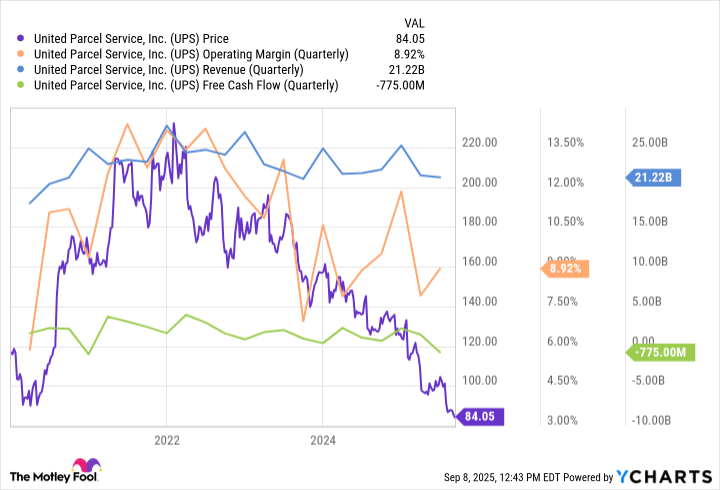Great businesses sometimes have ugly valuations. And United Parcel Service (UPS 0.40%), trading at less than $85 a pop, seems to be one of them.
The transportation stock hasn't had its best year. Indeed, it seems like every quarterly report, or at least the last handful, has given investors very little to be excited about. Another revenue decrease? Check. Parcel volume down? Check. Tariff uncertainty and withheld guidance? Check, check.
At the same time, this is UPS we're talking about. You know, the 118-year-old company that runs one of the world's largest integrated air-ground package networks. It averages over 22 million packages delivered per day and delivers parcels in 200 countries, and it basically invented its own shade of brown.
That's why seeing UPS trade under $85 makes one want to stop and ask, is this a deal? For investors wondering what Brown can do for them -- if anything -- here's what they should know.

Image source: Getty Images.
What went wrong
To understand what went wrong, we have to remember what went right. And what went right for UPS was, of course, its position during the COVID-19 pandemic. During the pandemic, while households were on lockdown and e-commerce spending was growing, UPS's daily package volume surged. In 2020, revenue spiked 14.2% to $84.6 billion, a then record high that it beat in 2021 when full-year revenue climbed to $97.3 billion.
Although these years weren't perfectly executed (delivery delays due to overwhelming volumes), they have become, in retrospect, the "golden" years for UPS investors as the stock was up over 60% from today's prices.
Fast-forward to 2025, and UPS is in a very different situation. Pandemic-fueled demand for e-commerce has cooled significantly, and new rivals in the parcel industry, like frenemy Amazon, have commandeered business that was once UPS's. Average daily volume in the U.S. fell over 7%, while operating margin was 7% -- a big whomp whomp for those who remember its double-digit margin during the pandemic.
The company is also adjusting to a structural hit from labor costs. Two years ago, it agreed to a five-year Teamsters contract that gave about 330,000 workers a significant raise. Full-time employees would see a total raise of $7.50 by 2028 (dished out progressively each year), while starting pay for part-time workers was also increased.
The agreement also had some technology stipulations, like preventing the introduction of driverless vehicles and drones without a UPS-union meeting, that could hurt UPS's cost-cutting abilities in the short term.
Softer economic conditions, plus new structural costs, have also coincided with UPS's own "better not bigger" initiative, which is aimed at cutting low-margin business in favor of packages with better margins. In effect, that has meant saying goodbye to Amazon, along with potentially other customers whose e-commerce business was high-volume but low pay. Indeed, by June 2026, UPS plans to cut Amazon package volume, once a high revenue driver, by 50%.
How UPS can still win
Aside from operating one of the densest and most efficient delivery networks in the world, I see a few bright spots in UPS's near-term.
The first is its small and medium-sized business segment (SMB), which has been growing. This customer base often offers higher prices per package than e-commerce giants. It's notable that SMB made up about 32% of U.S. volumes in the second quarter, a slight increase from last year.

NYSE: UPS
Key Data Points
Another bright spot is UPS's expansion into healthcare logistics. Indeed, the company already operates some temperature-controlled facilities, which offer customers special handling of medical devices, lab specimens, pharmaceuticals, and other sensitive materials. Like its SMB segment, packages in healthcare logistics are delivered with a high level of urgency that makes their handling more expensive than your average package of sneakers. According to CFO Brian Dykes, healthcare logistics grew revenue by 5.7% last quarter.
As far as valuation goes, UPS looks cheap by traditional standards. The stock trades around 12 times forward earnings, well below the S&P 500 (around 22) and slightly below its rival FedEx.
So, is UPS a buy today? For long-term investors with a three to five-year horizon, UPS looks pretty attractive at today's depressed price. That's even more the case if you're seeking income, as UPS has one of the highest annual yields (7.85% at today's price) that you'll find.
That said, this isn't a risk-free investment, and even long-term investors should keep their eyes on UPS's margins and volume trends. If UPS can deliver on today's initiatives -- and the economy avoids a deep recession -- today's buyers could see upside over the next few years, all while collecting a rich dividend.








